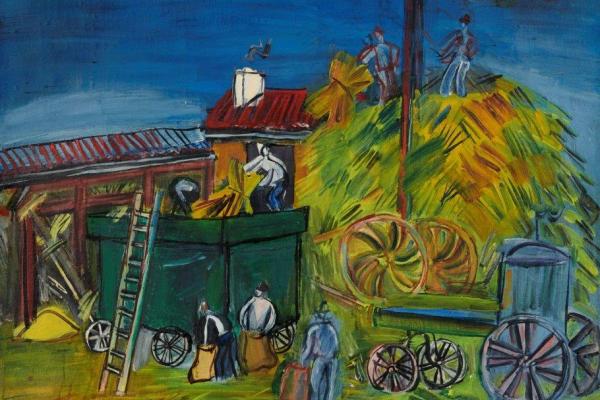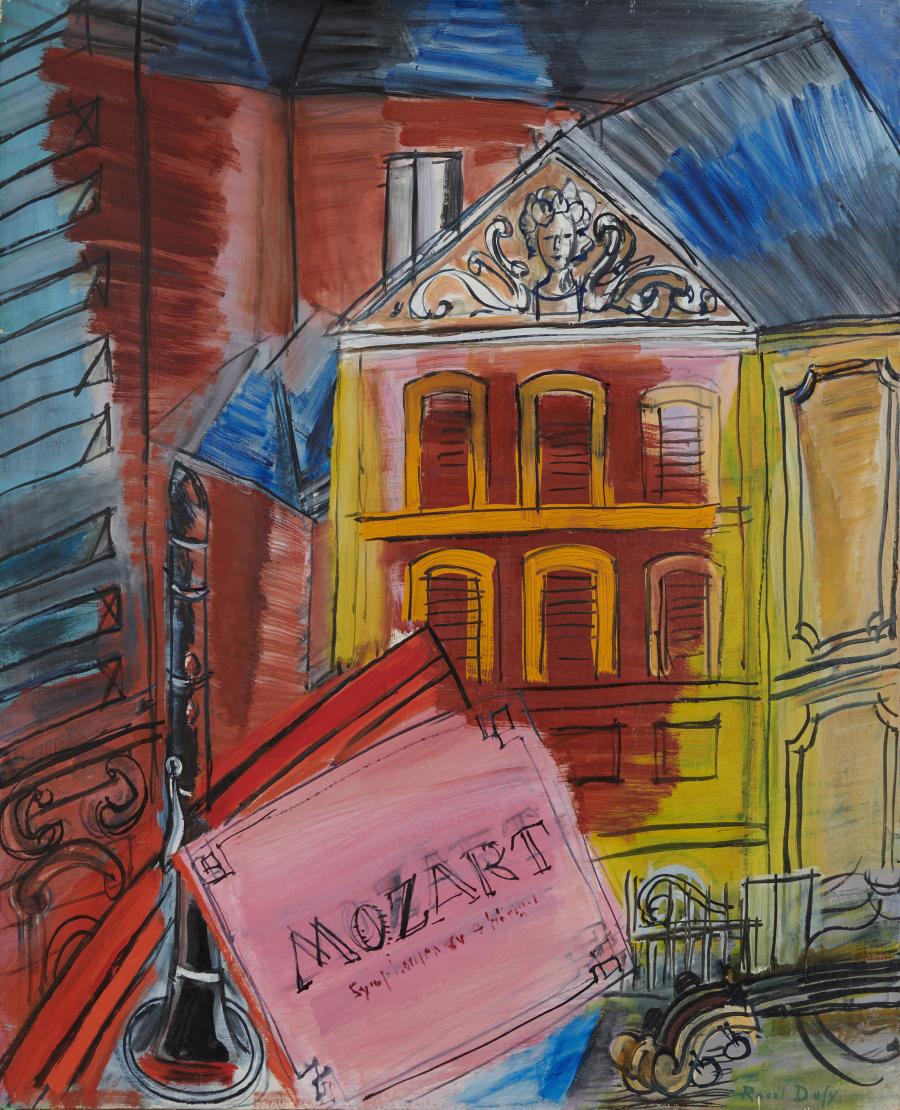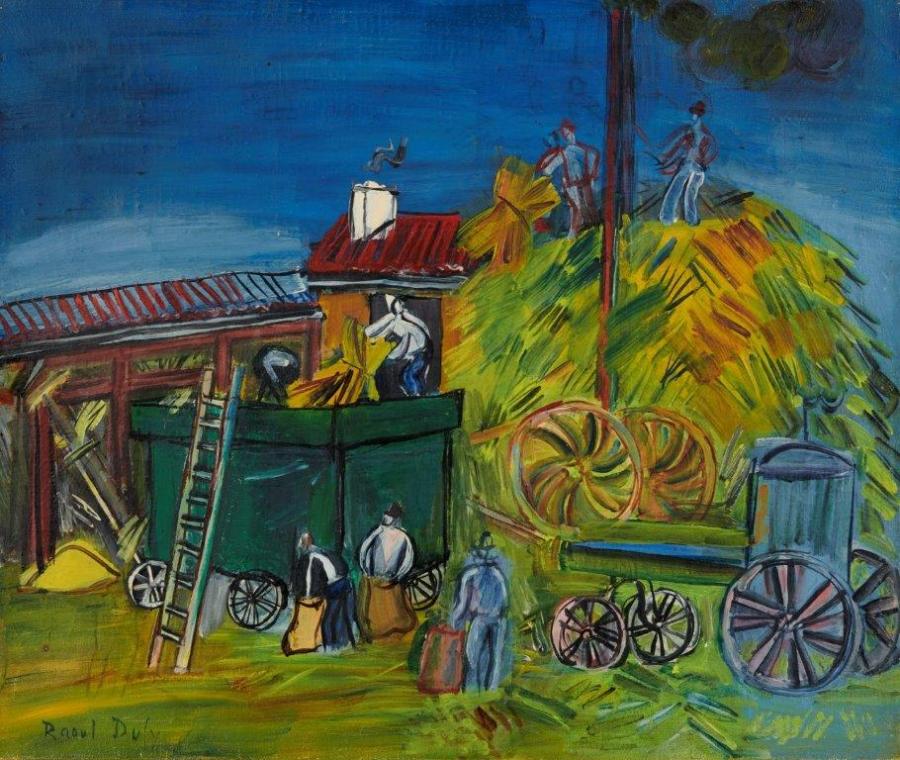Press article : Raoul Dufy, the Mozart of painting - La Gazette Drouot
Raoul Dufy, the Mozart of painting - La Gazette Drouot
- 4/18/24
- Paintings

"Le dépicage bleu", 1948-1949
When Raoul Dufy joined his friend the painter Othon Friesz in Munich in 1909, he probably took advantage of his stay to visit Salzburg and Mozart's house. Music, his other passion, had always been part of his life. His father, Léon, was an accountant but above all an organist and choirmaster at Saint-Joseph parish in Le Havre, and his brother Gaston wrote for the flute. As was often the case with the artist, his travels gave rise to thematic series of paintings, watercolours and drawings that he would return to throughout his career. The first Hommage à Mozart appeared in 1909 and played an important role in his work. It was to be the starting point for other tributes, to Bach and Debussy, as well as to classical and modern painting. This Hommage à Mozart, painted in 1952, a year before his death, revives a work from his youth and seems to continue the research begun at the time on "colour-light".
Raoul Dufy (1877-1953) - Hommage à Mozart, 1952
Oil on canvas signed at the bottom right, 81 x 65 cm.
Estimate : 100000/150000€
The story of a friendship
The painting, like Le Dépicage bleu painted around 1948, has a singular history and tells the story of a long friendship. They were part of the collection of Raymonde M., the Dufys' housekeeper when they lived in the painter's studio in Impasse de Guelma, Paris. After the couple left for Nice and then Perpignan in 1940, Émilienne Dufy and Raymonde M. "kept up a lively correspondence. One of Mme M.'s sons, Jean-Claude, even became Émilienne's godson", points out Jean-Pierre Besch, auctioneer at Besch Cannes Auction. When Dufy died, Émilienne returned to Nice and asked Raymonde M. to join her. She convinced her, again according to Jean-Pierre Besch, she would find a job for her husband at Nice town hall. "The paintings presented at the auction were donated by Émilienne and bear witness to their intimacy", continued the auctioneer. The two works, painted around the 1950s are radically different. Homage to Mozart comes from Dufy's cubist period, and it is difficult to understand his work without taking into account the musicality that animates his canvases. You have to imagine a painter conducting an orchestra," emphasises Fanny Guillon-Laffaille, author with her father Maurice Laffaille of the painter's catalogue raisonné (see Gazette No. 14, page 160), He was capable of painting his watercolours with a brush in each hand, sometimes composing in less than twenty minutes before the blotting paper, which he had previously moistened, dried". Yet she qualifies : "Raoul Dufy's cubist period is not the favourite period of collectors." Fans may not recognise in these vertical and oblique lines, which give a somewhat austere appearance to the musician's house, what would make Dufy so successful : the lyrical abundance of colours and shapes. Dufy rejected the overly rigid dogmas of Braque and Picasso. His friend Apollinaire, for whom he illustrated Le Bestiaire with thirty woodcuts in 1910, did not include him in his essay Les Peintres cubistes, published in 1913. Nevertheless, we can't help but be drawn to this "tonal painting", as described by the art historian Dora Perez-Tibi in the catalogue of the exhibition devoted to Dufy at the Musée d'Art Moderne de la Ville de Paris in 2008. His many Hommage à Mozart, which bear witness to his passion for music," she analyses, "are organised [...] according to a cubist pictorial rhythm in which plastic rhymes are orchestrated by a sonorous palette, already attesting to his concern to transfer Mozartian sonorities to visual art."
Raoul Dufy (1877-1953) - Le Dépicage bleu, 1948-1949
Oil on canvas signed
Estimate : 80000/100000€
A musicologist, Raoul Dufy was also, in the words of the critic Waldemar-George (1893-1970), an "image hunter". A reporter who took advantage of his strolls through the French countryside - from the Langres region to the wheat fields of Provence - to paint scenes of everyday farming life, like this canvas Le Dépicage bleu, painted around 1948. The theme, which illustrates the beginnings of mechanised farming in rural France in the early 1950s, seems far removed from those dear to the artist : the modernity of the towns of Normandy and the Côte d'Azur, regattas, horse races... Yet how can we fail to recognise in the rich palette of blues, ochres and greens, a symphony dedicated to celebration and joy?
Dufy suffered during his career, and still suffers today, from a misunderstanding, a very French antagonism. This is between art and craft, artists and decorators. In 1911, Dufy met the famous couturier Paul Poiret. He set up a fabric decorating business on Boulevard de Clichy in Paris and began working on prints and fabrics that, thanks to Poiret, would win him a wide audience. His approach was reminiscent of that of Arts & Crafts founder William Morris, and had its roots in medieval tradition. Nor was it far removed from the ideals of the most radical modernists, members of the Bauhaus in particular, who also demanded total art. Raoul Dufy continued his pictorial research, particularly on flowers, in the manufacture of fabrics and, in return, enriched his paintings with ornamental motifs.
Unfortunately, between the painter and the intransigent defenders of Adolf Loos' lapidary formula - "ornament is a crime" - there was a lack of understanding. Similarly, the artist was not always followed by a more 'classical' clientele, who were a priori more favourable to him. In his 1920 essay L'Art vivant (Living Art), the writer André Salmon recounts a scene at a Salon when he saw "a luxurious guinea-fowl dressed by Dufy laughing with all her insolence at a painting by Dufy". The most moving words about Raoul Dufy's work were probably by Gertrude Stein, who returned to France after the victory over Nazism : "One must meditate on pleasure. Raoul Dufy is pleasure. It was enough to ridicule the words of a Parisian gallery owner, reported by Maurice Laffaille in his Chronique d'une galerie de tableaux sous l'occupation, who, thinking he was criticising the artist, said: "Dufy is a little master. He's the Mozart of painting".
BY NICOLAS DENIS - LA GAZETTE DROUOT N° 16 OF APRIL 19th, 2024 pages 20 till 22
April Sunday 28th, 2024, Besch Cannes Auction OVV.


